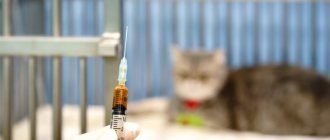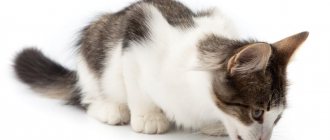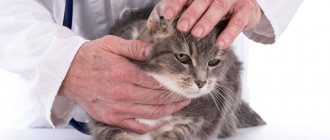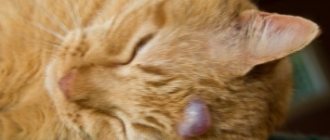Causes of pyometra Diagnosis of pyometra in cats Treatment of pyometra in cats Pyometra is purulent inflammation of the uterus, regardless of the cause (etiology) of the development of this process. Clinically, open and closed pyometras are divided, differing in the condition of the cervix. When the cervix is closed, the pathological process will take place inside the closed uterine cavity; clinical symptoms of general malaise may appear, such as a lack or decrease in the cat’s appetite, increased thirst, and general depression of the animal. When the cervix is dilated, the pus contained in the cat's uterus will flow out of the loop. However, given the general neatness of cats, moderate discharge may not be outwardly noticeable (the cat will simply lick it up), but yellowish, greenish or bloody spots may remain on the bedding or other place where the cat sleeps.
Main symptoms of urethritis
The first signs of the disease are frequent and difficult urination.
The animal sits on the tray for a long time, trying to urinate. A little later, severe pain when urinating is added to these symptoms. Blood can often be seen in the urine, and purulent discharge from the urethra appears. The cat loses his appetite and starts drinking a lot. In this case, very little urine is released from the bladder. There is a sharp increase in temperature, fever, and aggressiveness. With urethritis, cats cannot go to the toilet and sit in the litter box for a long time.
If treatment is not started in time, then complete intoxication of the body occurs: the animal begins to salivate profusely, a sharp unpleasant odor of acetone appears, emanating from the skin, saliva and urine, photophobia, and weakness.
This condition is called the acute form of urethritis, and it is often accompanied by complete or partial blockage of the urethra. There is also a chronic course of the disease, in which the cat urinates without difficulty, but often and painfully, and completely cured urethritis appears again and again. As soon as the animal becomes hypothermic or catches a cold, all the symptoms of the disease return.
Prevention measures
- Timely vaccination against infectious diseases.
- Regularly treat your cat for external and internal parasites.
- Isolation from stray or sick animals.
- Compliance with sanitary standards and rules for keeping pets.
- Excluding your pet's access to substances that can cause allergies.
- A balanced diet and not overfeeding the cat with treats.
If a cat walks outside, dust, dirt, and small debris may get into its eyes. It should be thoroughly examined every time after a walk, and for the purpose of prevention, you can periodically apply lotions and compresses with warm infusions of chamomile, calendula, and tea.
Nutrition
Dangerous
The appearance of some discharge requires attention and prompt assistance. Their occurrence can be provoked by:
- Development of a malignant tumor. With cancer, purulent discharge with a foul odor comes from the uterus. They indicate destruction of soft tissues. It is impossible to treat the pathology at home; you should immediately consult a doctor.
- Decomposition of the placenta. Sometimes after childbirth the placenta does not come out completely. The cat begins to behave lethargically, and watery discharge with bloody clots appears from under its tail. Cleaning must be done at a veterinary clinic.
- Uterine injury. The animal can be injured if surgery is unsuccessful. In this case, the discharge from the anterior passage is profuse and contains a large amount of blood. The cat must be provided with complete rest and other animals should not be allowed near. Place the bed in a separate room. It is impossible to determine the nature of the injury on your own; the help of veterinarians is required.
- Inflammation of the genital organs. Occurs for various reasons: due to hypothermia or infection after childbirth. The cat licks itself frequently and experiences frequent, painful urination. Often the infection enters the bladder, which leads to cystitis. It is necessary to protect the cat from drafts and not let it go outside. If infections are found in the urine, a course of antibiotic treatment is necessary.
- Vaginitis. The acute form of the disease can be the result of trauma during childbirth. Chronic vaginitis occurs as a complication after serious illnesses, such as chlamydia. Vaginitis comes in different types. With serous vaginitis, the discharge is cloudy, transparent, and is accompanied by the appearance of ulcers on the soft tissues of the vagina. Catarrhal-purulent vaginitis is characterized by cloudy yellow or white discharge and inflammation of the area under the tail. If vaginitis is not treated, it will develop into other diseases, such as cystitis and endometritis.
- Vaginal phlegmon. The cat's genitals swell and ulcers appear on them. The animal's temperature rises and there is purulent discharge with pieces of dead mucous.
- Endometritis. During this disease, the mucous membrane of the inner surface of the uterus becomes inflamed. The causes of the disease are varied, but most often it is a sexually transmitted infection and a side effect of drugs that suppress desire. Discharge with endometritis is spotting, profuse, mixed with blood. The cat takes a pose as if preparing to urinate, meows and arches its back.
- Pyometra. This is one of the forms of purulent endometritis. It is safe only for a castrated cat whose uterus and both ovaries were removed during sterilization. The main reasons are problems with hormonal levels, which are most often caused by drugs against desire, and incompletely cured endometritis. The cat feels unwell, lethargic, and white vaginal discharge appears.
Diagnosis of pyometra
The diagnosis of pyometra is made comprehensively by veterinary specialists. When the first signs of pyometra appear, cat owners should immediately contact a veterinary clinic, where veterinary specialists will conduct a clinical examination of the sick cat and perform an ultrasound - in which the uterus will look greatly enlarged with thickened walls and cysts. A blood test will be performed. With pyometra, the blood will show leukocytosis, a shift of the leukocyte formula to the left, hyperproteinemia, hyperglobulemia, the urea content reaches 300 mg.
What kind of discharge in cats is considered unhealthy?
Suspicions of a pathological process are caused by vaginal discharge of the following type and consistency:
- White, if they are not associated with pregnancy or childbirth, then indicate vaginitis or pyometra. An additional pathological symptom is an unpleasant odor.
- Yellow-colored or bloody, foul-smelling, occur with postpartum endometritis or miscarriage.
Purulent discharge
The inflammatory process begins with the release of liquid transparent mucus, which gradually thickens, becomes opaque, first white, then acquires a creamy, yellowish, greenish or brown color. Darkening of the exudate is a sign indicating the death of mucosal tissue.
Your cat is bleeding: what to do?
When blood flows from the vagina in drops, clots, or along with exudate, it means that the cat has developed hematometra - a life-threatening illness.
The symptom indicates a violation of the integrity of blood vessels. In this case, urgent veterinary assistance is required.
Pathology or normal phenomenon?
But first, we would like to reassure overly suspicious owners: if you see that in the first days after birth a small amount of mucous or bloody discharge is released from the cat’s genital tract, then there is nothing criminal in such a phenomenon. This is the norm.
To understand why these discharges appear in the first place, you need to know a little about the physiological characteristics of the postpartum uterus. After childbirth, the organ begins to gradually recover to its original state. This process is called "involution". During this process, the remaining pieces of the placenta, excess uterine epithelium, etc. are separated. All this comes out into the external environment in the form of postpartum discharge. At first they are cloudy, but soon they become transparent and viscous.
Thus, in the first few days, when the uterine cavity is cleansing on its own, there is no need to be afraid of discharge. O can persist for about three weeks, but still, with completely normal involution, the discharge should disappear after a week and a half.
Sometimes a small amount of dried “crusts” can be seen at the root of the animal’s tail. Discharge is not normal in all cases. And the uterus itself is not always “responsible” for their appearance.
Sometimes it is necessary to urgently seek help from a professional veterinarian:
- If you miss the placenta (that is, three placentas were produced for four kittens), contact your veterinarian immediately! Retention of placenta in cats is a serious pathology, often accompanied by the development of purulent-necrotic endometritis. The treatment is difficult, long, and often requires surgical resection of the uterus.
- If excessive bloody or watery discharge appears, you should immediately contact your veterinarian, regardless of the time that has passed since birth. Such “leaks” do not mean anything good.
- Please note that any discharge you notice directly during pregnancy is always a sign of some kind of pathology.
- Infections of the genitourinary system. Bladder diseases are very dangerous (since in females the infection can quickly penetrate the uterus), as well as diseases of the uterus itself. The latter is often indicated by purulent discharge from the external genitalia of the animal.
- In addition to the previous point, we note that bladder cancer can have similar effects. Those. In this case, thick pus is released from the external genitalia, often mixed with pieces of destroyed tissue, but the uterus and other organs of the reproductive system will be fine.
- Vaginitis (inflammation of the vagina). A very common complication of protracted, difficult labor (especially in primiparous animals), accompanied by the formation of numerous ruptures in the mucous membranes of the genital organs.
- All pathologies of the blood coagulation system are extremely dangerous for cats who have given birth. If your pet has such diseases (we are talking about relatively mild cases), any wounds received during childbirth will bleed for a very long time. In severe cases, the animal will completely die from massive bleeding.
- Again, during childbirth, foreign objects may enter the vagina, resulting in injury to the genital tract.
- If a cat has enuresis (i.e. urinary incontinence), then constantly secreted urine will lead to chronic irritation of the mucous membranes and even to their inflammation. This outcome is caused (as a rule) by congenital or acquired defects of the ureters, but in cats such pathologies are quite rare in practice.
- In extremely rare cases, an open defect (fistula) may form between the rectum and vagina. An extremely severe pathology leading to no less serious consequences. It is treated exclusively by surgery. If the disease is neglected, the animal will die from sepsis or similar causes.
All these signs can (and do) only indicate serious inflammatory processes in the organs of the reproductive system.
Symptoms of pathological discharge
Of course, the main clinical sign for all these pathologies will be vaginal discharge, but various variations are still possible due to the deterioration of the animal’s general condition:
- As we have repeatedly written above, pathology should be suspected if any uncharacteristic discharge appears immediately after childbirth or a few days after it.
- At the same time, cats begin to constantly lick the genital area. Sometimes they get so carried away by this activity that they even stop caring for their kittens.
- Often, with inflammatory diseases of the genitourinary system, the pet experiences severe pain, which is why it begins to behave inappropriately. She constantly runs, meows, and can literally roll on the floor. The animal cannot even feed the kittens normally. However, in such cases, we would recommend feeding babies artificially, since pathogenic microflora can get into the milk.
- A fairly characteristic symptom is constant, non-stop urination. This happens because the cat is constantly pushing.
- For the same reason, constant “big” hikes or involuntary bowel movements are possible. Due to the constant mixing of discharge from the genitals and feces, brown discharge may be observed.
- Apathy, feverish state, sharp increase in thirst.
Remember that if your pet is in a lethargic state and (especially) a noticeable drop in its overall body temperature, you must immediately call a veterinarian. These signs indicate septic processes. If you delay, your cat may very well die.
Possible pathologies
Most pathological causes are associated with inflammation and infection of the uterus. This can lead to infertility and even death. To avoid complications, it is necessary to diagnose the existing disease as soon as possible and begin its treatment.
Pyometra
The risk group includes unsterilized animals over 5 years old. Due to hormonal imbalance, pus accumulates in the uterus, so the cat develops copious brownish or cream-colored discharge. Spots of the corresponding color can be seen on the bedding and other resting places of the pet.
The most dangerous form of pyometra is closed. With this disease, the pus does not extend beyond the uterus. This is accompanied by acute pain and enlargement of the abdomen. Over time, the walls of the organ cannot withstand and become damaged. The contents spill into the abdominal cavity, causing the death of the animal.
Endometritis
If a cat's white discharge appeared shortly after birth, then placenta particles could remain in the uterus. Their rotting can provoke endometritis - inflammation of the uterine mucosa. In addition to delayed placenta, the disease can occur due to hormonal imbalance and infection of the genital organs.
The appearance of abundant mucopurulent exudate is accompanied by frequent urination, loss of milk and severe pain. An advanced form of endometritis is fraught with the development of pyometra, infertility and sepsis.
Hematometer
Scanty bleeding in a cat, accompanied by fever and cramping pain, is characteristic of hematometra. With this pathology, blood accumulates in the uterus, since it cannot pass through the endocervix (mucous membrane of the cervix). Narrowing or blockage of the cervical canal occurs due to:
- muscle spasm;
- abortion or miscarriage;
- uterine fibroids;
- congenital anomalies;
- incorrectly performed operations;
- frequent childbirth.
Accumulating blood attracts pathogenic microorganisms. Over time, this leads to purulent inflammation - pyometra.
Hydrometer
With a hydrometer, secretions produced by the uterine glands, transudate and exudate, accumulate in the uterus. If the cervical canal is open or only partially blocked, a small amount of white or clear fluid will leak from the loop. This pathology is most easily detected in a sterilized cat whose discharge is not typical.
Hydrometra is often a complication of the chronic form of endometritis. Over time, the walls of the uterus stretch and become thinner. Scarring and adhesions appear at the site of ruptures. Without timely assistance, death occurs.
Vaginitis
With vaginitis, the walls of the vagina become inflamed and covered with ulcers. The catarrhal-purulent form of the pathology is complicated by an abscess. A sick cat develops a viscous white discharge that resembles thick cream.
The main causes of the disease are a sharp decrease in immunity and postpartum vaginal trauma. Opportunistic bacteria (Escherichia coli, streptococci, staphylococci) living in the body are activated and cause infection.
Other diseases
In addition to the listed diseases, bleeding, copious mucus and pus can be a symptom of several other pathologies. These include:
- Malignant tumors
. Blood appears not only in mucus, but also in urine and feces. As the condition worsens, pus is released. Oncology often occurs due to hormonal imbalances caused by taking drugs to suppress desire. - Blood clotting disorder
. Hematological pathology is accompanied by the appearance of scarlet liquid or clots. - Vaginal phlegmon
. Inflammation affects the subcutaneous fat of the vulva. Due to the gradual growth of the organ, abscesses appear. The pus coming out of the vulva has a mucous consistency. - Uterine trauma
. The appearance of scarlet blood shortly after sterilization is a complication caused by careless surgical intervention. In this case, it is better to call a veterinarian at home, since transporting the animal can aggravate its condition. - Placental abruption or decomposition
. When placental abruption occurs, brown clots appear from the loop. If the kittens die in the womb, the color changes to green. Decomposition adds a strong, unpleasant odor. Bleeding may also occur. If these symptoms occur, you must urgently contact a doctor to prevent the death of the animal.
To identify a possible cause, it is necessary to take into account all accompanying symptoms. If the pet is active, eats well and takes care of the kittens, then you don’t have to worry about her.
Caring for your cat after surgery
After surgery (removal of the uterus and ovaries), your pet needs appropriate care. When carrying out care you must:
- Put a post-operative blanket on the cat (sometimes this is done in a veterinary clinic) so that the cat does not chew or lick the post-operative stitches.
- Inspect the surgical suture daily. If redness or inflammation appears at the suture site, the cat must be taken to the veterinary clinic where the operation was performed.
- Despite the fact that the cat may lose its appetite after surgery, the cat should have free access to water.
- After surgery, the cat is prescribed a special veterinary diet (pates) or chicken broth with chopped meat. The cat must be fed soft and semi-liquid food.
- If there is any deterioration in the general health of the cat, it is necessary to show it to a veterinarian.
Endometritis
Inflammation of the uterine mucosa. The cause is genital infections. Animals walking on the street, young cats under 3 years of age, when using hormonal drugs for estrus, an unbalanced diet, difficult childbirth, and a hereditary tendency are at risk.
The disease is considered in acute or acquired form. Let's look at the symptoms. In the acquired form, symptoms are mild. The pet looks healthy in appearance, but often licks itself, so the cat’s blood from the uterus is not visible. The danger is that this form can become purulent. This is due to increased accumulation of secretions due to thickening of the uterine mucosa. The secretion is a favorable environment for the development of infections. Characterized by copious discharge and increased body temperature. Urgent medical assistance is required.
Symptoms in acute form
:
- temperature increase;
- loss of appetite;
- copious discharge from the genital opening;
- often arches his back and assumes a posture for urination;
- abdominal enlargement;
- the external genitalia are inflamed.
At an early stage, antibiotics and antimicrobials are used. In case of purulent form, sterilization is carried out. To increase the body's defenses, immunomodulators are prescribed.
What does white discharge mean?
The appearance of white discharge from the anus and organs of vision is always alarming, since in most cases the color change is associated with the presence of pus and inflammation. If mucus was found on the loop, this may be normal.
Pathological changes in the body
The presence of white discharge may indicate the following pathologies and abnormalities:
- Infectious diseases of the genitourinary system. White or yellow discharge from the urethra may be associated with infection with chlamydia, toxoplasmosis, mycoplasmosis, etc. The mucus in most cases has an unpleasant odor. Sometimes there are no symptoms. Infection most often occurs during mating, so you should carefully select a partner for your cat.
- Pyometra. It is characterized by the presence of an inflammatory process with abundant formation of pus. There are several types of pyometra. If a cat's white discharge gradually comes out of the loop, this is an open form. It is easier to diagnose and treat. In the closed form, the discharge does not leave the uterus, which leads to its rupture and the further development of sepsis. Such pyometra is not always detected on time, since many owners mistake an enlarged abdomen and symptoms of intoxication for pregnancy.
- Oncology. Tumors occur more often in older cats. They cause white discharge from the urethra or anus. If the tumor is located in the intestinal lumen, its individual fragments may be present in the stool. In the early stages, cancer is asymptomatic, but later common symptoms appear: refusal to eat, anxiety, weight loss, etc.
- Development of complications after surgery. In such cases, the appearance of white discharge is associated with tissue infection. Most often, repeated surgery is required to eliminate the consequences. If you do not help the animal, the infection will develop rapidly.
- Vaginitis. Characterized by inflammation of the mucous membranes of the vagina. In most cases, the disease is asymptomatic, but some cats experience copious clear or whitish discharge. The animal experiences discomfort and often licks itself, trying to alleviate the condition.
- Phlegmon. Inflammation occurs, accompanied by the formation of abscesses. Mucus mixed with pus comes out of the urethra. The animal experiences pain and the temperature rises due to inflammation.
- Pathologies of the organs of vision. Most often, the appearance of whitish mucus from the eyes is caused by infections. They can develop independently or as a result of injury. The discharge is accompanied by redness of the protein, inflammation of nearby tissues, itching, the appearance of crusts, etc.
- Cystitis. Cystitis. Often has an infectious nature of origin. First, the animal experiences problems with urination. When the mucous membranes are damaged, blood first appears in the urine, and later pus, which is excreted only in the urine.
- Kidney diseases. These include pyelonephritis, glomerulonephritis, urolithiasis, etc. If internal tissues are damaged due to inflammation, microbial activity, or injury from stones, pus and blood appear in the urine.
- Gastrointestinal pathologies. In diseases of the stomach, intestines, pancreas and liver, discharge is found in the stool. In the initial stages it is clear mucus, later it becomes white and blood is added. In advanced cases, neighboring organs may become inflamed, and then discharge from the loop may appear.
- Inflammation of the anal glands. Accompanied by the appearance of purulent discharge from the anus and in the feces. The animal licks the anal area and can move its butt on the floor. Due to the discharge, the fur near the tail becomes wet. In advanced cases, fistulas form, from which pus comes out.
- Parasites. Most often, discharge appears in the stool. This happens due to worms. In feces you can sometimes find not only mucus, but also worms or their fragments. If the infection is severe, the cat begins to vomit, the hair falls out and becomes dull.
Dangerous diseases
The cat has bleeding on the second day after giving birth
Some brown, pink, clear and white discharge from a cat indicates dangerous diseases in your beloved pet. If she is not helped in time, the disease will progress, and ultimately some ailments lead to death, infertility and many other complications. Most often, veterinarians identify 7 diseases that affect animals. Some diseases occur through the entry of bacteria into the urethra and urethra.
Pyometra
Most often, this disease appears in older cats. When 2-3 months pass after estrus and the cat has not been fertilized, bacteria begin to develop in the uterine area, which can enter the body long before the onset of estrus. The fact is that without caring for the sperm and the development of the fetus, cysts form. As a rule, the main symptom of bacteria in the body is strong discharge, which can appear both during and after estrus. You can avoid this by sterilizing your cat on time.
The disease can be provoked by deterioration of hygiene standards during estrus, childbirth or operations. Risk factors: low physical activity of the cat, susceptibility to disease, inflammation, uncontrolled mating and much more. Along with the discharge, the cat's belly is rounded (lack of pregnancy), severe thirst and frequent trips to the toilet, bad behavior due to poor health, disheveled fur, and so on.
As the disease progresses, loss of appetite, vomiting, and diarrhea appear. Discharge with this disease is brown or white-brown in color.
Uterine trauma
Inflammation and trauma to the uterus occur as a result of various diseases, as well as birth injuries. The disease can progress and be accompanied by discharge and pain. This disease is also fatal. The more the disease progresses, the larger and more abundant the discharge will be. They cannot be left unattended, because they will lead to the imminent death of the pet.
Licking
The cat will constantly lick the genital opening; when the disease reaches the last stage, the animal will no longer have time to constantly lick the pus. Purulent discharge will be very noticeable on the floor where the pet sits, on the back of the fur. As with the previous illness, there will be severe thirst and frequent trips to the toilet, but the cat will practically stop eating. The volume of the abdomen will increase at high speed and in a few hours can reach such a size that it will look extremely unnatural. The cat will breathe very heavily, the owner will certainly pay attention to this.
Note! Frequent urination occurs because the slightest accumulation of urine in the bladder causes very noticeable pain. Bacteria can settle in the uterus 1-2 months before manifestation.
Vaginitis
The disease is characterized by swelling of the internal walls of the vagina and the first stage of the disease occurs calmly for the owner, since the cat will feel some discomfort, but it will not show it.
Symptoms in the second stage:
- Piteous meowing while going to the toilet;
- Attention from surrounding cats in the absence of heat at the moment;
- The pet will try to scratch the labia in different ways: on the carpet, furniture, or even begin to bite them;
- Grayish and white discharge and so on.
Endometritis
Another inflammatory disease of the uterus. Pathogenic microbes enter the uterus, multiply and cause inflammation. The first complication is poor health, problems with going to the toilet. The second complication is loss of reproductive ability. Deaths as a result of this disease are common. Occurs with low body resistance (weak immunity), postpartum complications, hormonal imbalance. It happens when animals take hormonal pills and they provoke various diseases.
Hydrometer
The uterine cavity accumulates fluid and mucous exudate. A less dangerous disease that shows few symptoms. The animal may not have sexual cycles (there will be no estrus and no subsequent pregnancy). As with any other disease, a diagnosis can only be made by a veterinarian, and discharge from a sterilized cat is almost the only noticeable symptom in the presence of such a disease. Treatment may sometimes require surgery.
animal surgery
Hematometer
It occurs when blood accumulates in the uterus and cannot be released due to a blockage in the cervical canal. The uterus ceases to function normally and may lose its functionality and reproductive capacity. The bloody discharge will not be profuse, but will cause discomfort. Bloody mucus (ichor) occurs due to poorly performed operations, spasms, miscarriages, fibroids and a number of other reasons.
The disease is rare; if left untreated, it can develop into pyometra, the treatment and consequences of which are more severe. The most severe symptoms appear as false contractions: the cat will take the appropriate position and meow pitifully. The cat may also have discharge.
Tumor processes
Cancerous tumors are often found in furry pets and are accompanied by copious discharge. Discharge due to the formation of a cancerous tumor will be accompanied by blood in the urine and feces, low appetite, ulcers, cough, and swelling.
Discharge appears as blood or pus from the genital area, as well as in those places on the body where wounds appear. It is difficult to treat tumors in animals, and the discharge may be no different from the discharge that occurs during estrus and other natural processes (if there is no blood, of course).
Reference! Some pets, especially those that go outside, develop wounds and scratches from fights with other animals. Sometimes an animal injures itself when it falls, and open wounds on the body must be treated and disinfected to prevent the entry of harmful bacteria. And there are often cases when purulent discharge appears from these same wounds on the body.
It is worth noting that not all tumors are related to oncology and the symptoms may differ, as well as the type and color of discharge during the disease. Sometimes they appear externally: on the front and hind legs, as well as on the body.
Treatment
With pyometra, the affected organ is most often removed, but in mild cases they may begin with antibiotic therapy. If pus appears in the discharge from the loop, this is a symptom of an infectious process that requires treatment with antibiotics. If a cat is diagnosed with a neoplasm, surgery or chemotherapy is performed. For uncomplicated vaginitis, the pet is prescribed douching based on chlorhexidine and furatsilin; for severe bacterial vaginitis, antibiotic therapy (Metronidazole, Amoxicillin) is prescribed.
For endometritis, antibiotics are prescribed to combat the pathogen and intravenous infusions of drugs to relieve intoxication. In some cases, hormonal medications are required to close the cervix. If the animal is more than 6 years old, it is recommended to remove all reproductive organs, since the risk of recurrence of endometritis is high. In case of false pregnancy, medications are prescribed to stop milk production, and less commonly, hormonal therapy.
Most diseases that are accompanied by discharge from the genital tract affect unsterilized cats. Therefore, complete sterilization of the pet will be a reliable prevention of these pathologies.
Watch this video on YouTube
Preventive measures.
100% prevention is planned sterilization of cats. If the animal is not of breed value and there are no plans to produce offspring from it, sterilization is the most reasonable solution. Surgical treatment of pyometra is the same as sterilization, but on an emergency basis. There is no point in bringing it to this state.
When keeping cats from which offspring are obtained, it is necessary:
- conduct an annual ultrasound of the uterus;
- exclude independent use of hormonal contraceptives;
- during the period of heat, monitor the cat’s hygiene;
- exclude accidental mating with street cats;
- If you notice any discharge from the vulva, contact your veterinarian immediately!
What is considered a physiological norm?
It is completely natural for a cat to have discharge during heat or estrus. The color of the discharge during this period is transparent, and the consistency is uniform without an unpleasant odor. The heat does not stop for several days, and the cat arches her back, exposes her hindquarters, and shows excessive playfulness and affection.
Pregnancy and childbirth
Discharge during pregnancy may appear in a cat up to the third week. This is due to the fact that a mucus plug forms in the cervix, the excess of which flows out. This is usually clear or stringy mucus that is difficult to notice because it comes out along with urine. Until the 6th week, yellowish discharge is very rarely observed in small quantities - excess amniotic fluid.
And only a day or two before birth does the mucous plug come off (at 9 weeks). This is a small clot of yellow or greenish tint.
During contractions and pushing in a cat, the presence of brown and bloody discharge from the uterus is normal. For some time after childbirth, liquid greenish discharge appears, gradually becoming lighter, and then completely disappearing.
Scarlet blood at any stage of a cat’s pregnancy is always a sign of pathology and can be a signal of uterine rupture. The reason for the discharge of brown clots is placental abruption or death of the fetus. Green ones with an unpleasant odor indicate a bacterial infection, most likely due to the death of the kitten and the beginning of the decomposition process.
A cat has white uterine discharge: normal or pathological?
White genital discharge, if it is not associated with pregnancy or labor, is pus. Most often they occur due to decreased immunity as a result of the use of hormonal contraceptives or hormonal anti-inflammatory drugs.
Staphylococci are activated, which constantly live in the body and do not cause harm to health with a normally functioning immune system. Vaginitis develops.
Another cause of the disease is the consequences of mating with a cat infected with chlamydia, toxoplasma, feline immunodeficiency virus, and mycoplasma.
After a difficult birth, fragments of the placenta remain in the uterus, they fester, leading to endometritis. The most dangerous pathology that begins with white discharge is pyometra. The discharge becomes colored or stops. If additional symptoms appear - depression, pain in the enlarged abdomen, it means that pyometra has passed into the most dangerous - closed form. The pus does not come out, but accumulates inside the uterus.
In older animals, suppuration may be a symptom of a tumor process. The main reason for the occurrence of neoplasms is repeated hormonal disruptions caused by the termination of an unwanted pregnancy or the use of drugs to disrupt estrus.
First, a false pregnancy develops. The animal gets worried, begins to prepare the nest, and spoils the situation. She produces milk, but no kittens. Repeated imaginary tightness is dangerous because it triggers the process of development of neoplasms.
Treatment of purulent discharge
Any discharge from an animal requires consultation with a veterinarian. Treating a cat on your own, at home using traditional methods, is unacceptable. It is necessary to accurately establish the cause of the discharge, make a correct diagnosis and, based on this, select treatment. At home, you need to create comfortable conditions for the existence of a sick pet (silence, warmth, peace) and organize proper nutrition for him. Everything else is prescribed by the veterinarian, and the owner only strictly follows the doctor’s instructions.
With pyometra, the affected organ is most often removed, but in mild cases they may begin with antibiotic therapy. If pus appears in the discharge from the loop, this is a symptom of an infectious process that requires treatment with antibiotics. If a cat is diagnosed with a neoplasm, surgery or chemotherapy is performed.
For endometritis, antibiotics are prescribed to combat the pathogen and intravenous infusions of drugs to relieve intoxication. In some cases, hormonal medications are required to close the cervix. If the animal is more than 6 years old, it is recommended to remove all reproductive organs, since the risk of recurrence of endometritis is high. In case of false pregnancy, medications are prescribed to stop milk production, and less commonly, hormonal therapy.
Most diseases that are accompanied by discharge from the genital tract affect unsterilized cats. Therefore, complete sterilization of the pet will be a reliable prevention of these pathologies.
READ Ringworm in cats symptoms and treatment
Purulent discharge in a cat is a reason to consult a doctor. In addition, alarming symptoms include:
- the cat constantly tries to lick the crotch;
- abdominal consolidation;
- poor appetite;
- complete indifference of the animal to what is happening around.
For each type of disease, its own treatment is prescribed, which can only be determined by a specialist. The easiest way to treat purulent discharge in a cat is to take antibiotics. If the discharge is too active, then only a doctor can decide on surgical intervention. This is required if it is necessary to remove infected organs. You should not treat your cat with folk remedies, as this can only worsen the course of the disease and even lead to the death of the animal.
– neoplasia of the urogenital tract;
– unhealthy position of the ureter;
– trauma to the vagina or the presence of a foreign body in it;
– urogenital infections;
– pyometra and others.
Yellow discharge is a dangerous sign
The most common sign of inflammation of the endometrium of the uterus is yellow or yellowish-whitish discharge from the external genitalia, which can also have an extremely foul odor. In these cases, the cat constantly licks the genital area, so that leaks of exudate cannot always be quickly noticed.
In severe cases (when pyometra develops), the pet's abdomen sag, it becomes apathetic, and a significant increase in overall body temperature is possible. Polydipsia and polyuria (increased thirst and urination, respectively) are also common. Intermittent fever is quite common; in much rarer cases, a sick animal may develop dehydration. When examining the blood, pronounced leukocytosis is noted (white blood cells multiply); cases of the simultaneous development of mild anemia are also described.
Treatment
Since endometritis in cats is severe and is often accompanied by septic processes, your pet needs to be treated quickly. The most common treatment method is the administration of loading doses of broad-spectrum antibiotics. Glucose and Ringer's solution are administered intravenously to help relieve intoxication. Alas, in severe cases, as well as with pyometra (when the entire uterus looks like a large ball completely filled with pus), it is impossible to do without removing both the uterus itself and the ovaries. Of course, such an operation is very traumatic and sometimes leads to unpleasant consequences due to a lack of hormones, but it still allows you to save the cat’s life.
In addition, in some cases of endometritis, antibiotic therapy helps a lot, but in such situations the kittens should already be weaned from their mother. Firstly, during treatment the mother's milk will almost certainly disappear. Secondly, some of the hormones may be in the same milk, the consumption of which by kittens will not lead to anything good. However, regular oxytocin is prescribed in almost all cases, since this hormone enhances uterine contractions, as a result of which exudate is removed from the organ cavity much faster. But! This only works in cases where the cervix is open.
The administration of oxytocin for severe pyometra may well lead to organ rupture. In addition, hormone therapy often causes side effects, including shortness of breath, vomiting, and frequent urination and bowel movements. Please note that in some cases the “side effects” are so severe that the administration of hormones has to be stopped and the patient switch to more “traditional” treatment methods. Treatment is continued until the light discharge becomes colorless, and then stops altogether.
Prevention
The best prevention of endometritis in a giving birth cat is not to try to help your pet without the appropriate education and experience. Leave this to an experienced veterinarian. In cases where the mother is already quite old, we strongly recommend immediately removing her ovaries and uterus (optional) after giving birth.
The operation 100% solves the problem of endometritis in the animal, but leads to the need for hormone replacement therapy, without which the cat’s health will also be in danger.
Childbirth in cats is a very important time . Carefully monitor your pet not only during the birth of kittens, but also after that. The sooner you notice signs that something is wrong, the greater the chances of a successful completion of the case.
Reasons for appearance
Discharge from the uterus in cats can occur for several reasons, which are generally considered abnormal and pose a threat to the health of the animal. Conventionally, all failures can be divided into two categories, which will accurately indicate the negative and neutral causes of these formations:
Neutral
- Estrus. Discharge in a cat during heat is completely normal and should not cause any particular concern to the owner. The estrus stops within a few days. Also, at this time, the pet owner may notice changes in the animal’s behavior - there is excessive activity, playfulness, the female arches her back.
- Postpartum period. After childbirth, greenish liquid may come out for some time, but gradually it becomes light and soon disappears completely.
- Pregnancy. For the most part, discharge during pregnancy in a cat signals that natural processes are occurring in the body that prepare the animal for the birth of offspring.
Negative
- Decaying placenta. When childbirth is not entirely successful, the placenta or part of it remains inside. So, the owner may observe bloody or slightly watery discharge from the cat. This indicates that the decomposition process has begun inside the body. Most likely, the animal will require surgical care.
- Genital infections. If a female has pink discharge with a possible reddish tint, this indicates a urogenital disease of the bladder, urinary tract, or uterus. They are odorless but have a thick texture.
- Cancer. Cancer can manifest itself not only as a general suppression of the immune system. Cancer cells affect many systems, not leaving the genitourinary system unattended. If a cat has purulent discharge from the uterus and with a characteristic odor, this indicates a danger that threatens the pet. Pus is a process of destruction that begins to occur from within.
- Inflammation of the genital organs. In this case, mucous and watery discharge is produced. The animal restlessly licks itself below, becomes somewhat aggressive and alarmed. There may be pain when trying to urinate.
- Uterine injury. Damage to an internal organ will always be accompanied by profuse and thick bleeding in the cat. The animal will need urgent medical attention and absolute rest so as not to aggravate the injury.
- Defects in the location of the ureter or sphincter dysfunction. This problem can cause the urine to become inflamed or irritated, which can then lead to purulent discharge in the cat.
- Disturbances in the functioning of the rectum. Due to this problem, liquid feces can penetrate into the vagina.
Diagnostics
It is very important to understand why exactly the cat has discharge from the cat's loop. The veterinarian will immediately perform a full medical examination of the animal, but specialists also resort to the following diagnostic techniques:
- A complete blood count (CBC), as well as its biochemistry, is additionally carried out by a urine test.
- Bacteriological examination of urine to exclude/confirm bacterial infection of the genitourinary system.
- Cytology of scrapings from the vaginal walls.
- Sowing of biomaterial obtained during scraping onto nutrient media. The analysis is extremely important for accurately determining the type of pathogen (which largely determines the method of subsequent treatment).
- Radiographs of the abdominal cavity. The technique is valuable because it allows you to visually assess the condition and size of the uterus, as well as other pelvic organs.
- Ultrasonography of the abdominal cavity (carried out for the same purpose as the previous study).
- Colposcopy. This is the name of a diagnostic technique that involves examining the vagina, cervix and the uterus itself (provided that the cervix has not yet closed) using a special device (very reminiscent of the “hose” that is inserted into the stomach during gastroscopy).
- If suspicious areas are found during colposcopy in the vagina or other organs, a tissue sample (biopsy) must be taken. It is subsequently used for cytological examination.
- Carrying out serological blood tests in many cases can also accurately identify the causative agent of the disease.
- It is recommended to conduct contrast radiography of the kidneys, when contrast agents are first introduced into the blood and settle in these organs. In the pictures they glow brightly, giving a clear and contrasting picture.
- If poor blood clotting is suspected, the quantity/quality of coagulation factors is assessed.










